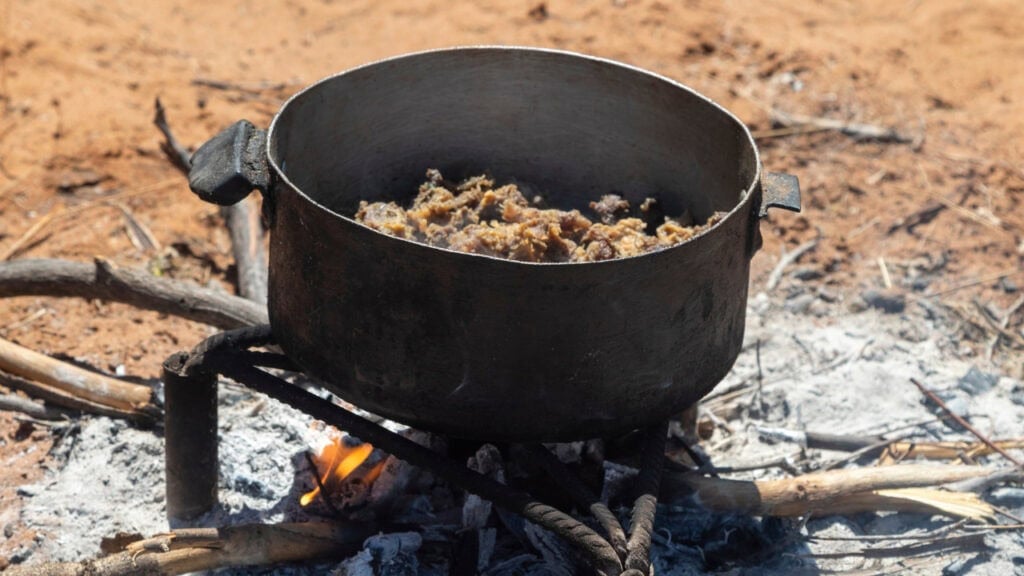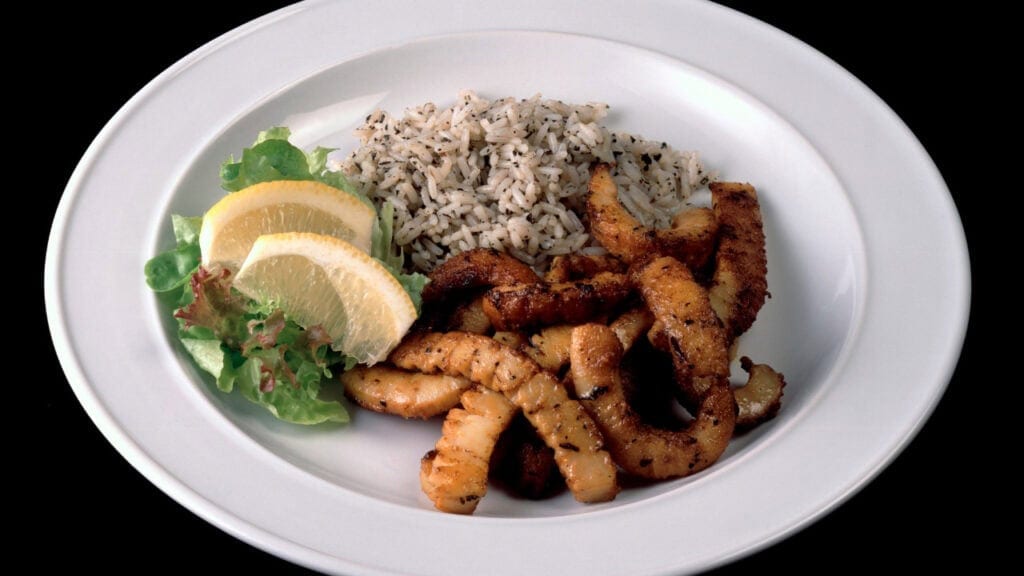Botswana boasts a rich culinary tradition that draws on its history and reflects its diverse communities. Rooted deeply in traditional practices, Botswana’s cuisine is a blend of timeless flavours and contemporary influences.
Dishes like seswaa, a hearty meat delicacy, and morogo, a green leafy staple, underscore the nation’s adherence to locally-sourced ingredients and age-old cooking techniques.
As you journey through Botswana, you’ll do far more than just delight your taste buds. You’ll also discover a food culture that celebrates this wonderful country’s welcoming spirit and its people’s values of decency and generosity.
1. Seswaa, Chotlho or Tshotlo
Description: Seswaa is a flavoursome traditional dish, usually made from beef, mutton or goat’s meat. The meat is boiled in just enough salted water to cover it, and some recipes add an onion. The meat is simmered gently for several hours until it is really tender and then it is shredded or pounded into a fine texture.

Seswaa can be served on its own, but it’s more usually served with beans, rice or maize porridge known as ‘pap’ or ‘sadza’. It can also be served with bread or used as a filling in sandwiches.
Occasion: This popular dish is a staple at special occasions, celebrations and traditional ceremonies.
2. Bogobe Jwa Lerotse
Description: This tasty traditional dish is made with sorghum porridge (bogobe), and the flesh of lerotse, a melon native to Botswana. The dish combines the nutty flavour of sorghum with the sweet and slightly tangy flavour of the melon, resulting in a dish that’s both hearty and refreshing.
The melon is peeled, deseeded and chopped, and then boiled in water until soft.
Once cooked, the lerotse is stirred into sorghum porridge and flavoured with salt, sugar, or other traditional spices. The resulting dish has a porridge-like consistency and a lovely delicate flavour given to it by the melon. Typically the bogobe is stirred with a traditional wooden whisk called a lehetho. Sour milk can also be added to the dish.
Occasion: Typically enjoyed as a breakfast dish or a light meal. It’s also served at weddings and other social gatherings.
3. Morogo, or African spinach
Description: Morogo refers to a variety of wild leafy greens that is cooked rather like spinach throughout southern Africa. The leaves from many plants such as amaranth, blackjacks, cowpeas, pickerel weeds, or spider plants are used and this can vary from region to region.
This staple in Botswana cuisine is known for its high nutritional content, essential vitamins and minerals. It’s often cooked with tomatoes, onions, and groundnuts.
Occasion: It’s enjoyed with meat, fish or sadza (pap) and served at cultural and life events like weddings and funerals.
4. Dikgobe, Izinkobe or Lekgobe
Description: This traditional dish has been a staple in Botswana households for generations. It basically consists of sorghum, beans and samp (processed maize) that are cooked together. Fat or oil is often used, with salt as a typical seasoning.
Meat can be added and ingredients like onions, tomatoes, and peppers are often used to give it more flavour. The beans and samp are soaked separately overnight, and then simmered together until fully cooked. Dikgobe is often flavoured with tomato, onion, and chilli peppers.
Occasion: Dikgobe is often served for lunch and as part of the fare at social and cultural events. At funerals dikgobe is one of the only two acceptable starches (along with sorghum) that can traditionally be served.
5. Phane (Mopane Worms), Madora, Amacimbi or Masontja
Description: Protein-, mineral- and fat-rich mopane worms offer excellent nutrition and are considered a great delicacy in many parts of southern Africa. They are harvested from the mopane trees that they mostly feed on. Their gut contents are removed, they’re washed, and then par-boiled.

Afterwards they are salted and dried in the sun or smoked to preserve them. They can be eaten as a delicious crunchy snack, fried, or rehydrated and cooked with either tomato, onion, chilli or a peanut sauce. The export of dried mopane worms to Europe has become a million dollar industry in southern Africa.
Occasion: Often enjoyed as a protein-rich snack or added to stews and served with sadza and green vegetables.
6. Madombi (dumplings)
Description: Soft, steamed madombi dumplings are a great favourite in Botswana! Though recipes vary, the basic recipe combines maize meal, water and salt to form a stiff dough. Small portions of dough are shaped into round or oval dumplings which are then simmered in boiling water for about 20-30 minutes.
Madombi dumplings are traditionally served with meat stews or vegetable dishes.
Occasion: A staple accompaniment for many Botswana families with their daily meals, but also served for special occasions, family gatherings, and celebrations.
7. Tswii (Water Lily Bulbs)
Description: Tswii are the bulbs of the water lily plant (Nymphaea lotus) that grows in rivers and in Botswana’s famous Okavango Delta. The bulbs are a traditional staple food in the northwestern part of Botswana. Tswii can be cooked with fish, meat, or chicken.
The meat and tswii are often cooked together over an open fire until they are soft and tender. Tswii can also be boiled separately until cooked. Tswii is often served as a side dish with traditional dishes like seswaa or chicken stew.
Occasion: Tswii is a seasonal delicacy, especially in regions close to the Okavango Delta.
8. Tswana Chicken or Groundnut Stew
Description: This iconic Botswana dish offers a hearty meal and delicious blend of savoury and nutty flavours. The chicken has peanut butter, ginger, garlic and onion added to it, and the dish is traditionally served with rice. It’s often cooked over an open fire in a three-legged iron pot which adds to its delicate and slightly smoky flavour.
Occasion: Tswana chicken is served at many cultural and social events.
9. Mogadu
Description: The main ingredient of this flavourful stew is tripe, the edible stomach lining of cattle, pigs or sheep. It’s a staple of African food culture and is regarded as a delicacy in most African cultures. It’s prepared by slicing the tripe and flavouring it with garlic, ginger and chilli.
Most recipes include a chopped onion and green pepper as basic ingredients, as well as medium curry powder and mutton stock.
Occasion: Enjoyed with meat, fish or pap as part of many families’ daily diet. It’s also served at events like weddings and funerals.
10. Fatcakes, Vetkoek (Fried Bread Dough)
Description: These famous fried bread dough ‘balls’ are typically filled with a savoury ground beef mixture. They’re available at most fast food shops and takeaway restaurants throughout Botswana, and are also sold as street food by many roadside vendors throughout the day.

Occasion: No festival or cultural event in Botswana would be complete without them!
At Discover Africa, we’ve long known that warm and welcoming Botswana is a premier holiday and safari destination. Have these delicious dishes whetted your appetite for visiting this marvellous country? We’ll be delighted to advise you on your trip and tailor an unforgettable Botswana safari for you!
Author: Gavin Denner
Published:
Last Update:
Part of the Botswana Safari Collection